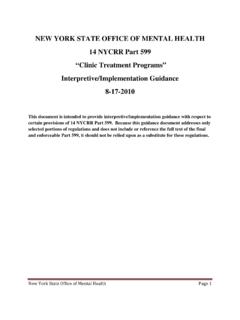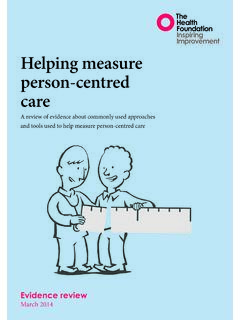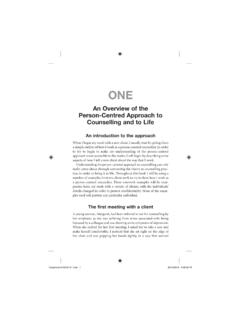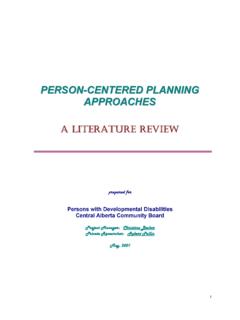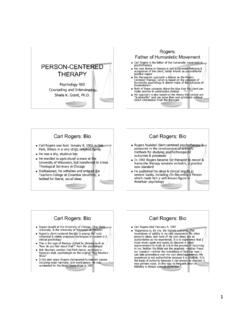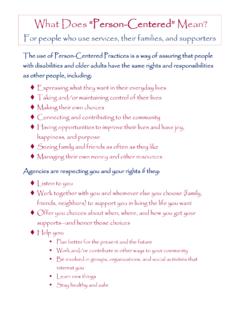Transcription of Person Centered Approaches DEVELOPING POSITIVE …
1 DEVELOPING POSITIVE Approaches FOR. Person Centered Approaches ENGAGING THE UNENGAGED CLIENT. Engagement Technique: Make a Connection One of the key principles of the Person - Centered approach is to convey unconditional POSITIVE regard for your clients. By making a connection you will help your clients feel accepted and important. This technique should enhance your ability to interact with your clients. OVERVIEW OF TECHNIQUE: If you know you are going to meet a client for the first time, no matter what the context intake, individual session, group meeting, leisure, employment, or other activity it is good practice to contact the Person prior to the meeting, by telephone or in Person at the agency.
2 Introduce yourself and briefly go over the date and time of the appointment and what the content of the meeting will be, if it is an activity or seminar, and what he can expect. Tell the Person you are looking forward to meeting him or her. It is good practice to remind people in general of their appointments when possible, not because they are incapable of doing this themselves, but because you communicate the fact that you are looking forward to meeting them or having them participate in a given activity. This telephone call can greatly facilitate engagement, and helps a Person feel that his or her participation is valuable. Even after discharge, a telephone call can aid in maintaining a feeling of continuity and reinforces the important role of the agency in the client s life, whether or not he is physically present.
3 Center for Rehabilitation and Recovery Engagement Technique: Establish Safety The Person - Centered approach emphasizes the need to relate to your clients with empathy. One way to do that is to address their possible fears about annihilation or rejection. Establishing Safety is a technique that should enhance your ability to interact with your clients. OVERVIEW OF TECHNIQUE: We cannot bring psychological help to our clients until we establish at least a minimal sense of safety. Practitioners must be sensitive to the possibility that certain clients may fear that professionals may physically harm them. If a practitioner senses that a client may be frightened, the practitioner can initiate a conversation about safety.
4 For example, the practitioner might say, Is there anything I can do to help you feel more comfortable and safe (such as sitting farther away, not staring, leaving the door open, not taking notes, etc.)? It is also important to review safety guidelines with clients who may be at risk of harming themselves or others. In addition to physical safety, practitioners must create an emotionally safe environment. This can be done by exploring a client s worst apprehensions about the helping relationship. And, at different times, it can be helpful to ask the client how he or she is experiencing the relationship. By addressing problems in the helping relationship, you can strengthen the relationship.
5 Center for Rehabilitation and Recovery Engagement Technique: Ask Open-ended Questions One way to sustain the Person - Centered approach is by asking open-ended questions. Such questions give your clients the space to share their own perspective on problems and opportunities. This will help you understand their thoughts and feelings, which facilitates the process of DEVELOPING empathy for them. This technique of asking open-ended questions should enhance your ability to interact with them. OVERVIEW OF TECHNIQUE: Open-ended questions generate discussion. Make your best effort to enter the engagement process without making assumptions about your client. Remind yourself that the client is the expert about himself and that you are there to learn from him and help him attain his goals.
6 Remember that self-revelation is a gradual process, and that trust first needs to be established before a client will feel comfortable disclosing certain things. By asking open-ended questions, you provide the client with the space to speak from her own perspective and the choice about what she wishes to disclose at that moment. For example, you can ask What would you like to talk about? What's been going on? , or How did that make you feel? During the engagement stage, you are seeking a better understanding of their thoughts and feelings about several topics: a) the problem for which they are seeking help . history, consequences, and implications, b) feelings about seeking help, c) efforts to solve the problem in the past, and d) motivation to work on the problem and move forward with his or her life.
7 Center for Rehabilitation and Recovery Engagement Technique: Actively Listen For the Person - Centered approach to work, you need to actively listen to your clients. Active listening conveys unconditional POSITIVE regard for the client. It is also necessary for empathic understanding, which leads to empathic responding. This helps build strong relationships. The technique of active listening should enhance your ability to interact with your clients. OVERVIEW OF TECHNIQUE: Active listening is the most basic, fundamental skill in the engagement process. By giving your full, undivided attention to someone, you are communicating the idea that what a Person has to say is important to you.
8 Create an environment as free from distractions as possible. Be aware if your mind starts to wander and refocus your attention on the Person and what he has to say. It is often the case that a Person just needs someone to listen. Your listening activity will help the Person contain her thoughts and ideas. If you are not available to listen or engage with a Person who needs to talk at a given time, you might say: I really want to hear what you have to tell me. Unfortunately, I'm unable to do that right now. Can we make a time to speak? Through active listening, you will learn what is important to a Person and what she needs. Your response will address what the Person has said, rather than what you think, or what you have to say.
9 At all times, it is essential to convey respect for your client and what she has to say. Center for Rehabilitation and Recovery Engagement Technique: Provide Validation & Feedback The Person - Centered approach emphasizes the need to create an emotionally safe place where your clients can feel accepted. One way to do that is to regularly provide validation and feedback when clients share their experience. This technique should enhance your ability to interact with your clients. OVERVIEW OF TECHNIQUE: By reflecting back to the client what you have heard, you both can work towards greater clarity if a Person is describing a feeling, idea or desire. Validating a Person s sense of helplessness, anger or sadness lends recognition of what the Person is experiencing, and can also normalize it, it is understandable that you feel anxious if you have just been insulted ; it is natural to feel deep sadness when we experience a loss.
10 Helping someone give a name to a feeling or desire can enhance self-expression and the feeling of control. Center for Rehabilitation and Recovery Engagement Technique: Express Empathy Expressing empathy is an essential part of the Person - Centered approach . This technique should enhance your ability to interact with your clients. OVERVIEW OF TECHNIQUE: Empathy is the art of imagining the client s experience or feeling state, of putting one s self in the shoes of the client. To be empathically attuned to the client creates a sensitive form of receptivity in the worker. One is not just listening and responding but attempting to see the world from the perspective of the client in a highly human manner.

